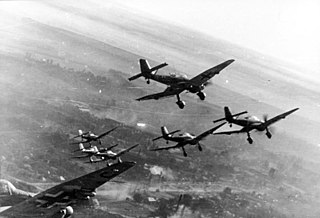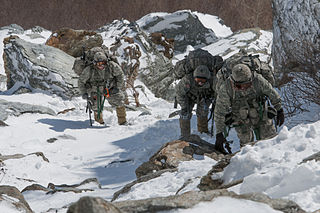Related Research Articles

The Italian Armed Forces encompass the Italian Army, the Italian Navy and the Italian Air Force. A fourth branch of the armed forces, known as the Carabinieri, take on the role as the nation's military police and are also involved in missions and operations abroad as a combat force. Despite not being a branch of the armed forces, the Guardia di Finanza has military status and is organized along military lines. These five forces comprise a total of 340,885 men and women with the official status of active military personnel, of which 167,057 are in the Army, Navy and Air Force. The President of the Italian Republic heads the armed forces as the President of the High Council of Defence established by article 87 of the Constitution of Italy. According to article 78, the Parliament has the authority to declare a state of war and vest the powers to lead the war in the Government.

World War II or the Second World War was a global conflict that lasted from 1939 to 1945. The vast majority of the world's countries, including all the great powers, fought as part of two opposing military alliances: the Allies and the Axis. Many participants threw their economic, industrial, and scientific capabilities behind this total war, blurring the distinction between civilian and military resources. Aircraft played a major role, enabling the strategic bombing of population centres and delivery of the only two nuclear weapons ever used in war. It was by far the deadliest conflict in history, resulting in 70 to 85 million fatalities, mostly civilians. Millions died due to genocides, including the Holocaust, as well as starvation, massacres, and disease. In the wake of Axis defeat, Germany, Austria and Japan were occupied, and war crimes tribunals were conducted against German and Japanese leaders.

The total number of military and civilian casualties in World War I was about 40 million: estimates range from around 15 to 22 million deaths and about 23 million wounded military personnel, ranking it among the deadliest conflicts in human history.

Pietro Badoglio, 1st Duke of Addis Abeba, 1st Marquess of Sabotino, was an Italian general during both World Wars and the first viceroy of Italian East Africa. With the fall of the Fascist regime in Italy, he became Prime Minister of Italy.

The North African campaign of the Second World War took place in North Africa from 10 June 1940 to 13 May 1943. It included campaigns fought in the Libyan and Egyptian deserts and in Morocco and Algeria, as well as Tunisia.

The Italian campaign of World War II, also called the Liberation of Italy following the German occupation in September 1943, consisted of Allied and Axis operations in and around Italy, from 1943 to 1945. The joint Allied Forces Headquarters (AFHQ) was operationally responsible for all Allied land forces in the Mediterranean theatre and it planned and led the invasion of Sicily in July 1943, followed in September by the invasion of the Italian mainland and the campaign in Italy until the surrender of the German Armed Forces in Italy in May 1945.

The Second Battle of the Piave River, fought between 15 and 23 June 1918, was a decisive victory for the Italian Army against the Austro-Hungarian Empire during World War I. Though the battle proved to be a decisive blow to the Austro-Hungarian Empire and by extension the Central Powers, its full significance was not initially appreciated in Italy. Yet Erich Ludendorff, on hearing the news, is reported to have said he 'had the sensation of defeat for the first time'. It would later become clear that the battle was in fact the beginning of the end of the Austro-Hungarian Empire.

Mountain warfare or alpine warfare is warfare in mountains or similarly rough terrain. The term encompasses military operations affected by the terrain, hazards, and factors of combat and movement through rough terrain, as well as the strategies and tactics used by military forces in these situations and environments.

The Allies, formally referred to as the United Nations from 1942, were an international military coalition formed during World War II (1939–1945) to oppose the Axis powers, led by Nazi Germany, the Empire of Japan, and the Kingdom of Italy. Its principal members by the end of 1941 were the "Big Four" - United Kingdom, United States, Soviet Union, and China.

The Allies, or the Entente Powers, were an international military coalition of countries led by France, the United Kingdom, Russia, the United States, Italy, and Japan against the Central Powers of Germany, Austria-Hungary, the Ottoman Empire, and Bulgaria in World War I (1914–1918).

The Battle of Vittorio Veneto was fought from 24 October to 3 November 1918 near Vittorio Veneto on the Italian Front during World War I. After having thoroughly defeated Austro-Hungarian troops during the defensive Battle of the Piave River, the Italian army launched a great counter-offensive: the Italian victory marked the end of the war on the Italian Front, secured the dissolution of the Austro-Hungarian Empire and contributed to the end of the First World War just one week later. On the 1st of November, the new Hungarian government of Count Mihály Károlyi decided to recall all of the troops, who were conscripted from the territory of Kingdom of Hungary, which was a major blow for the Habsburg's armies. The battle led to the capture of over 5,000 artillery pieces and over 350,000 Austro-Hungarian troops, including 120,000 Germans, 83,000 Czechs and Slovaks, 60,000 South Slavs, 40,000 Poles, several tens of thousands of Romanians and Ukrainians, and 7,000 Austro-Hungarian loyalist Italians and Friulians.

The Balkans theatre or Balkan campaign was a theatre of World War I fought between the Central Powers and the Allies.

World War I (WWI), also known as the First World War, was a global conflict fought between two coalitions, the Allied Powers and the Central Powers. Fighting took place throughout Europe, the Middle East, Africa, the Pacific, and parts of Asia. One of the deadliest wars in history, it resulted in an estimated 9 million soldiers dead and 23 million wounded, plus another 5 million civilian deaths from various causes. Millions more died as a result of genocide, and the war was a major factor in the 1918 Spanish flu pandemic.

The Royal Italian Army (RE) was the land force of the Kingdom of Italy, established with the proclamation of the Kingdom of Italy. During the 19th century Italy started to unify into one country, and in 1861 Manfredo Fanti signed a decree creating the Army of the Two Sicilies. This newly created army's first task was to defend against the repressive power in southern Italy, exemplified by rulers like Francis II of the Two Sicilies. The Army of the Two Sicilies combated against criminals and other armies during this time of unification. After the monarchy ended in 1946, the army changed its name to become the modern Italian Army.

The Italian Co-belligerent Army, or Army of the South were names applied to various division sets of the now former Royal Italian Army during the period when it fought alongside the Allies during World War II from October 1943 onwards. During the same period, the pro-allied Italian Royal Navy and Italian Royal Air Force were known as the Italian Co-belligerent Navy and Italian Co-belligerent Air Force respectively. From September 1943, pro-Axis Italian forces became the National Republican Army of the newly formed Italian Social Republic.
The following outline is provided as an overview of and topical guide to World War I:

The Italian Corpo Aeronautico Militare was formed as part of the Regio Esercito on 7 January 1915, incorporating the Aviators Flights Battalion (airplanes), the Specialists Battalion (airships) and the Ballonists Battalion. Prior to World War I, Italy had pioneered military aviation in the Italo-Turkish War during 1911–1912. Its army also contained one of the world's foremost theorists about the future of military aviation, Giulio Douhet; Douhet also had a practical side, as he was largely responsible for the development of Italy's Caproni bombers starting in 1913. Italy also had the advantage of a delayed entry into World War I, not starting the fight until 24 May 1915, but took no advantage of it so far as aviation was concerned.

The 10 cm M. 14 Feldhaubitze was a dual-purpose field and mountain gun used by Austria-Hungary during World War I. Between the wars it was used by Austria, Italy, and Poland. During World War II it served as the standard medium howitzer of the Royal Italian Army with the designation Obice da 100/17 modello 14 and after 1943 captured weapons were used by Nazi Germany's Wehrmacht under the designations 10 cm leFH 14(ö) and 10 cm leFH 315(i). After World War II an updated howitzer remained in service with the Italian Army until 1975.
The 4th Army was a World War I and World War II field army of the Royal Italian Army.

Carlo Vecchiarelli was an Italian general. He was a veteran combatant of the First World War. Between the two world wars he held the positions of Military Attaché at the Italian Embassy in Prague, Honorary Field Assistant to King Vittorio Emanuele III, Military Attaché at the Italian Embassy in Vienna, commander of the 7th Alpini Regiment, of the I Alpini Brigade, of the 47th Infantry Division "Bari", of the 132nd Armored Division "Ariete", and of the V Army Corps of Trieste. During the Second World War he was commander of the I and XX Army Corps, and of the 11th Army stationed in Greece, with headquarters in Athens. After the proclamation of the Armistice of Cassibile of 8 September 1943, after receiving ambiguous instructions from the Supreme Command, on the morning of 9 September 1943 he gave the order to surrender all heavy weapons to the Germans, in exchange for the latter's commitment to repatriate the Army. The Germans, however, soon betrayed the agreement and had the troops of the Eleventh Army sent to Germany as Italian military internees. Vecchiarelli himself was arrested and imprisoned in Poland before being handed over to the Italian Social Republic, which sentenced him to ten years' imprisonment for "anti-German behaviour in Greece". He was released by the partisans at the end of the war.
References
This article needs additional citations for verification .(August 2023) |
- ↑ "Italian Army – 24 May 1915" (PDF). 314th.org. 2016-09-23. Retrieved 2023-08-14.